| Dutch Disappointment? |
Historian
Arthur Percival looks at the Dutch influence on buildings
in East Kent
and suggests that there's scope for much more research
into their histories. |
|
Sandwich, guidebook writers often say, is like
a Dutch town. Well, yes and no. Yes, in the sense
that from across the levels from the distance there’s
a distinct resemblance. With its two prominent church
towers, and its core still encompassed by medieval defences,
it could be mistaken for one of those gorgeous ancient
towns you see in Holland. Come closer along the road
from Ramsgate, half-close your eyes, and you could almost
dignify the tower of St Peter’s with the onion-shaped
Dutch-type cupola that some imaginative illustrators
have given it.
But, although it may seem sacrilegious to say so,
walk about the town and the ‘Dutch’ vision
crumbles. Where are all those crow-step, tumbled and
curly gables which are two-a-penny in towns in the Netherlands?
There are hardly any. Admittedly, Manwood Court’s
crow-steps (Fig 1) make a striking impression as you
arrive by road from Canterbury, but where are all the
others? There are tumbled gables on Fishergate, there’s
a curly gable on the south side of St Peter’s (Fig
2), and there’s the ‘Old Dutch House’
in King Street (Fig 3), although it doesn’t look
terribly Dutch. Mind you, it does have a curly gable
at the back.
|
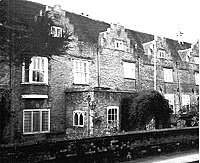 |
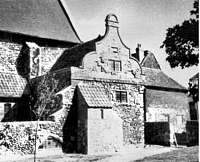 |
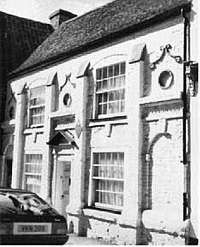 |
| FIG 1: Manwood Court’s
crow-stepped gables. Photographs: Arthur Percival
unless otherwise indicated |
FIG 2: South vestry
at St Peter’s church. |
FIG 3: The Old Dutch
House, King Street. See The Sandwich Society
Journal, Vol 2, No 6, for a full account of the
1457 attack. |
|
|
Dutch bricks? Well, they figure in a handful of properties,
but no more. Yes, a house at the Bay sports curly gables
but this is a Cape Dutch job done in the Twentieth century
when Kent-born Sir Herbert Baker (1862-1946) brought
the style to Britain - and Cape Dutch, although related
to East Kent ‘Dutch’, is another story.
What a disappointment for visitors looking for the
flavour of Holland! There are many more curly gables
in Deal than in Sandwich, as there once were in Ramsgate.
But wait. Perhaps in Sandwich there used to be more?
Yes, indeed there were, although still not enough to
give the impression of a Low Countries town. There were
three fine ones on the south side of the Cattle Market
(Fig 4), but they have gone. There was also one by the
Guildhall itself, which was used to house smaller animals
on market days. It was a late Victorian building and
reflected the then wave of interest among architects
and builders in reviving the East Kent Dutch style (Fig
5).
Still, there never were that many buildings in what
we would recognise as a ‘Dutch style’. All
perhaps a bit odd, given that after its harbour had
started silting up the town was given a new lease of
life by Protestant refugees (‘strangers’)
from the Low Countries, and that these constituted a
substantial ethnic minority. Is there an explanation?
Let’s look at the historical, architectural and
topographical background first. To begin with, the term
‘Dutch’ can be misleading. The refugees came
from the whole of the Netherlands which, in the Sixteenth
century, consisted of most of present-day Holland and
Belgium and a chunk of north-eastern France. This had
been a possession of the Dukes of Burgundy from 1385
but became one of Spain when Charles, Duke of Burgundy,
became King of Spain in 1516.
Serious Catholic persecution of Netherlandish Protestants
began in 1550 when the Inquisition was imposed. Although
refugees may have begun to arrive in Sandwich earlier,
they were officially authorised to settle in the town
in 1561. They formed their own church in the following
year, and by 1564 Norwich was trying to lure some of
them away. Their skills were much in demand.
What about their building skills, though?
Many came from towns almost as tightpacked as Sandwich.
Their forebears, like Sandwich people, had built timber-framed
houses but timber was in shorter supply in much of the
Netherlands than it was in Kent, and brick (and to a
lesser extent dressed stone) took its place earlier
than it did here (Fig 6).
|
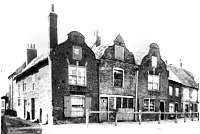 |
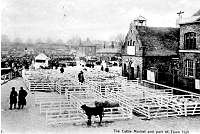 |
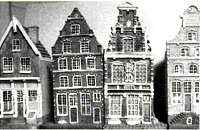 |
| FIG 4: Shaped gables
on the south side of the Cattlemarket, later demolished.
Photograph reproduced with kind permission of
Sandwich Guildhall Archives. |
FIG 5: Cattle market
showing Dutch gabled animal shed to the right. Photograph
reproduced with kind permission of Ray Dean, from
his Collection. |
FIG 6: Models showing
the evolution of the Netherlandish gable. |
|
|
The practice was to build almost all town houses with
their gables facing the street. Netherlanders liked
individuality so, rather than build plain gables, they
put up ornamental ones. At first these were crow-steps,
in a style common to much of northwest Europe, including
Scotland and parts of the English east coast. Or, if
crow-steps were too expensive, you could settle for
a tumbled gable with muizetanden (mouseteeth formed
by courses of bricks laid at right-angles to the gable-pitch).
But then the Spanish influence kicked in, and Renaissance
scrolls and other motifs were added to create a more
exotic outline. In Dutch these were known as halsgevels.
These were often busy with pilasters, string courses,
swags and ornamental ovals.
You couldn’t afford these? Then you settled for
a simple curvilinear, or ‘shaped’, gable with
the distinctive curly outline we associate with ‘Dutch’
gables in East Kent. Later on, and finally, the halsgevel
was made bolder by eliminating all but one or two of
the steps and string-courses and building the pilasters
uninterruptedly from the base to the top of the gable.
This was the baroque gable.
Because so much of the Netherlands is low-lying, and
soils are often alluvial, the builders of these houses
took no chances. Instead of waiting for subsidence and
then repairing the resulting damage at great expense,
they installed tie-bars (ankers) to clamp walls to beams
from the very start. In keeping with the refined quality
of facades, these were of elegant profile, unlike their
crude English counterparts. Soon it dawned on builders
that tie-bars need not be plain. They could also be
decorative (sierankers) or informative, or both. Decorative
ones could have scrolls at top and foot. Informative
ones could carry the date of the building (jaartalankers),
or the initials of the owner, or both, again beautifully
executed. Prime local examples of jaartalankers are
those that date Manwood Court (the former Sir Roger
Manwood Grammar School) to 1564. The building itself
is like a hybrid Netherlandish-English manor house,
with crow-step gables from the Low Countries and hood
moulds from England over the first-floor windows.
Because the soils around Sandwich were similar to those
in the low-lying parts of the Netherlands, and ideal
for market gardening, some of the refugees who arrived
in the town took up this line of business. Others doubtless
then branched out into larger-scale farming. Perhaps
now it begins to become clear why the town lacks a more
prominent architectural legacy of the Netherlandish
settlement that took place here. The settlers had their
work cut out to establish themselves in their new surroundings.
This took time. Once they had set down firm roots, towards
the end of the Sixteenth century, they had little need
and hardly any opportunity to build new properties.
Most of the town’s houses were then of recent,
or fairly recent, vintage and did not need redeveloping.
And in a place so densely built up, there were few empty
building plots. Presumably it was only where there were
really ancient, tumble-down properties that new Netherlandish-style
houses, such as those in the Cattle Market, got built.
In scale and finish these did not match the models
they emulated. About one of the reasons for this we
can be sure. Although Dutch bricks were being imported,
the builders - probably Kentish - chose to work with
the bricks with which they were familiar. These were
larger than their Netherlandish counterparts so detailing
could not be as refined. As a result East Kent’s
‘Dutch’ houses and gables have a kind of hearty
English flavour - they are bolder, and simpler. And
if the builders put up two storeys rather than three
or four, this was probably simply because this was all
that need dictated.
Thus it is that Sandwich’s real Netherlandish
heritage is not in the town itself but in villages close
by - Ash-next-Sandwich, Minster, Wingham, Woodnesborough
and Worth, for example. Indeed it also radiates from
it - up the Stour valley as far as Chilham, in the Little
Stour valley, in the Wantsum valley at Sarre and St
Nicholas-at-Wade, at Reading Street in St Peter’s
(Broadstairs) and in villages behind Deal like Great
Mongeham and Ripple (Fig 7). Beyond, there was a fine
example in Faversham and another two in nearby Oare,
of which one survives.
These ‘Dutch’ houses are one of the main
features that distinguish the extreme east of Kent from
the rest of the county. They have an exotic flavour
that reminds us that it is the part of England closest
to the Continent. There must be around two hundred of
them in all, yet though many are prominent in their
setting they have never attracted the attention they
deserve, and have never been seen as a ‘family’
by guidebook writers. Fortunately most have been well
cared for by successive owners, but if you are observant
you will notice a few curly gables which have been ignominiously
shaved down. You can usually recognise them because
what remains bears other traces of Netherlandish influence,
like decorative or informative tie-bars, string-courses
which once linked steps in the gable, or blind oval
recesses which do humble duty for the more elaborate
Netherlandish prototypes.
If only to complete the Sandwich settlers’ story,
it is worth illustrating some of these houses. A word
of warning, first. Some vernacular architectural historians
argue that they have little to do with refugees from
the Netherlands but are simply examples of ‘artisan
mannerism’, typified by elaborate brickwork based
on Netherlandish prototypes, which they say became popular
in the early Seventeenth century. This is an argument
that can be persuasive but the jury is still out on
it.
The fact is that many or most ‘artisan mannerist’
buildings are on, or close to, England’s east coast,
or easily reached from it by river. You will find them
in Suffolk, Norfolk, and as far up as Newcastle-upon-Tyne.
There were a few fine examples close to the Thames in
the London area. In the delightful North Yorkshire village
of Cawood, on the Ouse between Selby and York, you will
see several, looking almost as though they had strayed
from the Sandwich area. In some cases the houses may
have been put up by Netherlandish immigrants, or their
children or grandchildren; in others, by merchants and
skippers trading with the Netherlands. The well-known,
and very striking, ‘Dutch’ houses on The Strand
at Topsham in Devon certainly owe their origin to trade
links.
A clinching argument in the case of the ‘Dutch’
houses around Sandwich is that most have (or had) not
only curly gables but such other features as sierankers
or jaartalankers. Only the Netherlanders had the helpful
habit of dating many of their buildings. Would that
the Brits had too, but perhaps they felt that after
fifty years or so a dated house would seem exactly that
- dated - to prospective buyers.
|
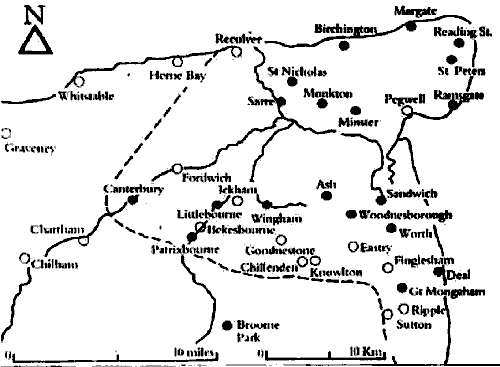 |
FIG
7: Map showing the influence of Netherlandish vernacular
architecture in East Kent and blind oval recesses
which were simply not features of contemporary native
design.
Map reproduced with kind permission of Arthur
Percival |
|
|
Let’s begin our short tour with the one house
in Sandwich that calls itself ‘Dutch’ - the
Old Dutch House in King Street. As already noted, the
street facade doesn’t look terribly Dutch, although
it’s undoubtedly exotic, with lots of busy brick
detail. It becomes intelligible only when it is analysed.
Four brick pilasters feature prominently. Just below
the eaves they tail off anti-climactically in wedge-shaped
caps. No-one can be certain, but it looks very much
as though they once ‘supported’ a curly gable,
as similar pilasters still do at Tudor Manor, Wingham
Well.
The facade is symmetrical, and at either end on the
ground floor are keystoned arches whose inspiration
is probably Netherlandish. There are similar, but shallower,
relieving arches over the two ground-floor windows.
In spaces that would otherwise be blank at either end
of the first floor front, and in its middle, are curious
decorations contrived out of small bricks, perhaps from
Holland. These look very much like a Kentish bricklayer’s
ingenious but rather clumsy attempt to reproduce details
from a Netherlandish facade. You can picture him having
been shown a rough sketch and trying to copy what he
saw. Some similar details appeared on a house (now a
shop) near the station in Preston Street, Faversham
but though the building still stands, its front has
been progressively butchered over the last hundred years.
A house in Delf Street (Fig 8), which was nearly opposite
the present cinema and seems to have been demolished
in the 1930s to make way for a Co-op store (now car
showrooms), looks as though it had gabled Netherlandish
detailing: certainly it sported sierankers. The complex
facade of The Pellicane in the High Street still has
some detailing which may be Netherlandish in inspiration.
Perhaps the most convincingly Netherlands inspired
building close to Sandwich is School Farm at Guilton
(Figs 9-10), at the western end of the original A256
through Ash-next- Sandwich. From the distance its gables
look really exotic. This is because although the designer
could not run to the frills of Low Countries prototypes
and was working in bigger Kentish bricks, he tried to
reproduce the characteristic gable outlines by giving
them bulbous contours. He added two tiers of pilasters,
supported by string courses, and incorporated jaartalankers
to date his little masterpiece to 1691.
|
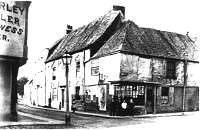 |
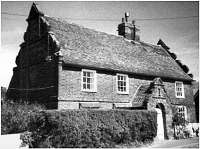 |
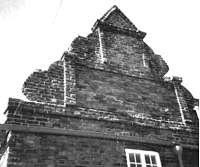 |
| FIG 8: Dutch influence
on house in Delf Street. Photograph reproduced
with kind permission of Sandwich Guildhall Archive
|
FIG 9: Guilton School
Farm, Ash. |
FIG 10: Two tiers
of pilasters on gable end of Guilton School Farm.
|
|
|
Not to leave a job half-done, he gave the neat little
porch a curly gable, complete with blind oval recess
and sieranker (decorative tie-bar). At this late date
the client could not possibly have been a first-generation
immigrant. Perhaps it was a great-grandson or great-grand-daughter
who cherished their Netherlandish roots. After all,
most folk of Continental Protestant descent are still
conscious of their antecedents; there wouldn’t
be a thriving Huguenot Society otherwise.
It’s worth noting that in this case the gables
don’t face the street, as they would have done
in the Netherlands and did in the case of the Sandwich
examples that have been lost, but are at right-angles
to it, on the flanks walls. This way, in their particular
setting they are more conspicuous - no point in taking
so much trouble if they were not far-seen. Nearby, but
secluded, is Poulton Manor, Woodnesborough (Figs 11-12).
Here a timber-framed house was transformed by the addition
of two large brick wings, with bold curvilinear gables
at both ends of each, not to mention another pilastered
gable over the new entrance. Despite the clash of materials
and styles the design outcome is hugely appealing.
|
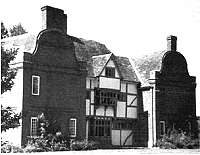 |
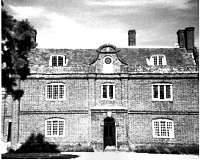 |
| FIG 11:
Rear view, Poulton Farm, Woodnesborough. |
FIG 12:
Front view, Poulton Farm, Woodnesborough. |
|
| Tudor Manor at Wingham
Well (Figs 13 and 14) has already been mentioned. With
its giant pilasters supporting a curly gable, it comes
closest in East Kent to baroque gabled prototypes in the
Netherlands. Winklandoaks Farm at Ripple was probably
of similar type but, if so, has lost its gable. Still
in Wingham, along the Staple road are Letterbox Cottages
(Fig 15). No curly gables now but just look at the eastern
one. It has a pediment, betraying that it once had one
which has since been shaved down to save on upkeep costs.
|
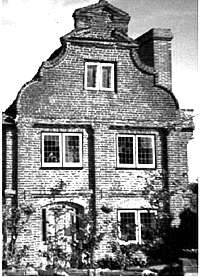 |
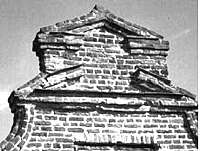 |
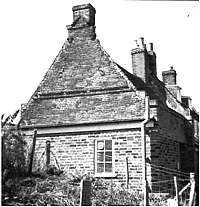 |
| FIG 13: Tudor Manor,
Wingham Well. |
FIG 14: Gable end
at Tudor Manor, Wingham Well. |
FIG 15: Gable end
at Letterbox Cottages, Staple Road, Wingham. |
|
| Further along the Canterbury
road, at Littlebourne, are several curvilinear-gabled
buildings. Most prominent, at the junction with The Green,
is the Anchor Inn, with its gable perhaps designed to
attract travellers’ attention. On The Green itself
is a picturesque row of cottages (Figs 16 and 17) with
a curly gable at either end, though the one on the north
is now obscured by a Victorian house. (It’s quite
common for gables to suffer this fate: just wander around
Middle Street and its many tributaries in Deal, and you
will see several which are now barely visible.) |
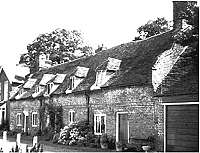 |
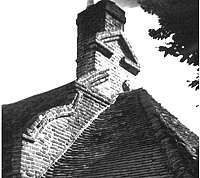 |
| FIG 16: Row of cottages
on The Green at Littlebourne. |
FIG 17: South gable
meets garage roof at the end of the row of cottages
on The Green. |
|
| The Old Vicarage in Nargate
Street (Fig 18) has a curly gable which is double-pedimented,
like those on The Green, but this time there’s also
room for a blind oval recess in its apex. There is a similar
recess at the top of one of the chimneys, and a curly-gabled
two-storey porch. The list could go on and on but there
is not space for it here. Suffice it finally to mention
Hode Farm at Patrixbourne (Figs 19 and 20), which sports
not just a curly gable (dated 1674) but also a splendid
crowstep one, perhaps a little older. |
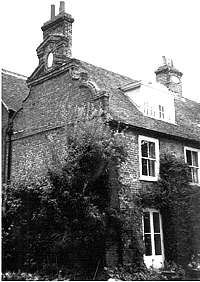 |
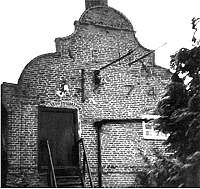 |
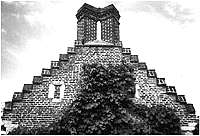 |
| FIG 18:
Gable end of The Old Vicarage, Nargate Street, Littlebourne.
|
FIG 20:
Crow-stepped gable at Hode Farm. |
FIG 19:
Curly gable, dated 1674, at Hode Farm, Patrixbourne.
|
|
|
One disappointment perhaps is that the East Kent ‘Dutch’
style is not still a feature of the local vernacular.
Here in England in the aftermath of the Modern Movement
architects are wary of designing what their colleagues
might denounce as nostalgic ‘fakes’. Not so
in Holland, where traditional-style buildings are still
put up. In East Kent the Netherlandish influence first
began to be noticed in the late Nineteenth century and
the outcome was that in places like Ickham, Faversham,
Sandwich and Wingham, a few ‘repro’ curly
gables appeared. In Margate the trustees of Draper’s
Almshouses gamely insisted that they appear on new ranges
to match those on the original (1709) one. But after
this - nothing, except recently for a new shop in The
Parade at Canterbury and the addition of curly gables
to a pair of Victorian cottages at Graveney. It was
the late Sir Patrick Abercrombie who inspired this writer’s
interest, stretching back over forty years, in East
Kent’s ‘Dutch’ heritage. In his [Sir
Patrick’s] great 1920s pioneering structure plan
for the coalfield he pinpointed it as a topic worth
further study. Having secured his blessing, I dutifully
‘collected’ as many examples as I could, and
looked at the Netherlandish influence further afield.
However, what I have never had time to do is correlate
the physical evidence with the documentary. In at least
some cases, hopefully, the original title deeds of the
properties concerned will have survived. These could
make rewarding reading. Since they prove title to land,
rather than the structures on it, they seldom record
when properties were built, rebuilt or remodelled. They
do, however, certainly contain information about owners
and often about tenants and, by implication, may reveal
when important changes took place, referring for example
to a ‘new-built messuage’. Is any reader game
for some intensive, but important and rewarding, research?
|
©
Arthur Percival MBE MA DLitt
Honorary Director of the Fleur de Lis Heritage Centre,
Faversham and
former Sandwich resident. This article was originally
published in the Journal of The
Sandwich Society.
Sadly, Arthur died at the end of 2014. |
|
|
|
|